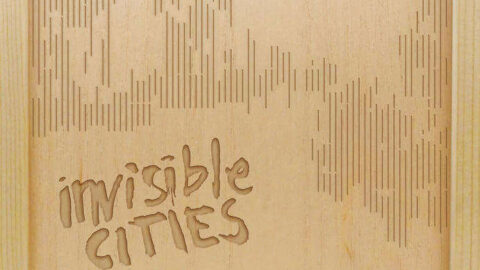Everything about Christopher Cerrone’s Invisible Cities project is stylishly executed. Judging from the beautifully designed digital booklet, I am jealous of the lucky owners of the limited edition wooden-encased version. This opera was first performed in LA’s Union Station in 2013 involving headphone-wearing audiences encountering singers and dancers moving amongst the public. In this studio recording, the music and text have undoubted style and beauty but, in the end, do not wholly succeed without the other elements of the opera.
It starts promisingly with explosive gestures and delicious instrumental colours. Satisfyingly brutal rasps of trombone and double bass contrast with tender winding threads of sound. It becomes clear that Cerrone’s writing for instruments and voices is attractive and accomplished. John Adams praises the “evocative power” of this piece, asking us to listen “on headphones, preferably in the dark.” We are immediately transported to an exotic, richly coloured world. Marco Polo (Ashley Faatoalia) arrives at the court of Kublai Khan (Cedric Berry) who asks the explorer to explain his empire’s decline. There is a chorus of water nymphs or babbling crowds that populate the series of cities that Marco Polo describes.

There are striking moments throughout the piece. Isadora begins with bells of piano harmonics, transformed after sensual flute and spiraling vocals into low sonorous chimes. There is gorgeous vocal writing in the chorus incantations of Kublai Kahn and a lovely moment when Marco Polo’s voice drops and cracks as he sings of “old age”. I loved the watery splashes of percussion and piano in Armilla – the city constructed entirely of water pipes – and the way the vocal line breaks up into dislocated upbeats at the end of Part 4. The piece ends with Marco Polo quoting T. S. Eliot’s call to “arrive where we started and know the place for the first time.” This final section is the most satisfying musically, the slow building of soaring vocal loops over a sinuous bass line creating a sense of ecstatic revelation.
The vocal and instrumental performances are very strong throughout. The two soloists have richness and power. The chorus is well balanced and Nick Tipp’s sound engineering deserves special praise. There is thoughtful and creative use of spacing, from whispering voices and violin lines dancing from left to right to the intimacy of the closely recorded voices at the end of the prologue.

Without visual content and choreography, the libretto and music lacks pace. While there are many poetic moments in the text, the libretto doesn’t have the characterisation or emotional shading needed to sustain us through a work of this length. The work’s deliberate austerity and avoidance of the specific keeps the listener at a distance. Cerrone sacrifices dramatic pacing and plot to the exploration of archetypes, concepts and the conjuring of atmosphere. This approach works well in the abstract, but opera always needs character and story, even opera that bravely avoids conventional staging and explores new forms of audience interaction. It needs you to care about the protagonists. There are moments of successful drama, e.g. the comic babel-like mass of voices that burst from the opening of ‘Language’, but this soon settles into a familiar sombre mood over a B-flat tonic. The harmony throughout is static, often meditating on a dorian mode or two-note oscillation giving the sense that we are dealing with elegant still pictures and descriptions rather than storytelling. This may well be an effective event in its fully staged incarnation, but lacks a little in this format, even listening with headphones in the dark.
























